ACC307: CEO Compensation, Agency Problems & Performance at Woolworths
VerifiedAdded on 2023/06/11
|9
|2866
|416
Report
AI Summary
This report assesses managerial pay and the impact of agency theory on business, particularly focusing on Woolworths Company. It evaluates how managerial pay, contingent on managerial or firm performance, achieves a balance between motivating performance and managing risk. The report examines the CEO's compensation contract, analyzing short-term and long-term components, performance-based proportions, and accounting measures used for bonus determination. It also explores potential accounting decisions a CEO might make to maximize their bonus and justifies remuneration components through the lens of agency theory. Furthermore, the report discusses how bonus plans can mitigate agency problems between managers and shareholders, issues for lending officers in banks, and covenants in debt agreements to reduce risks. It identifies agency problems banks should be concerned with and the accounting information that aids in this process, ultimately concluding with insights on aligning managerial incentives with shareholder interests.
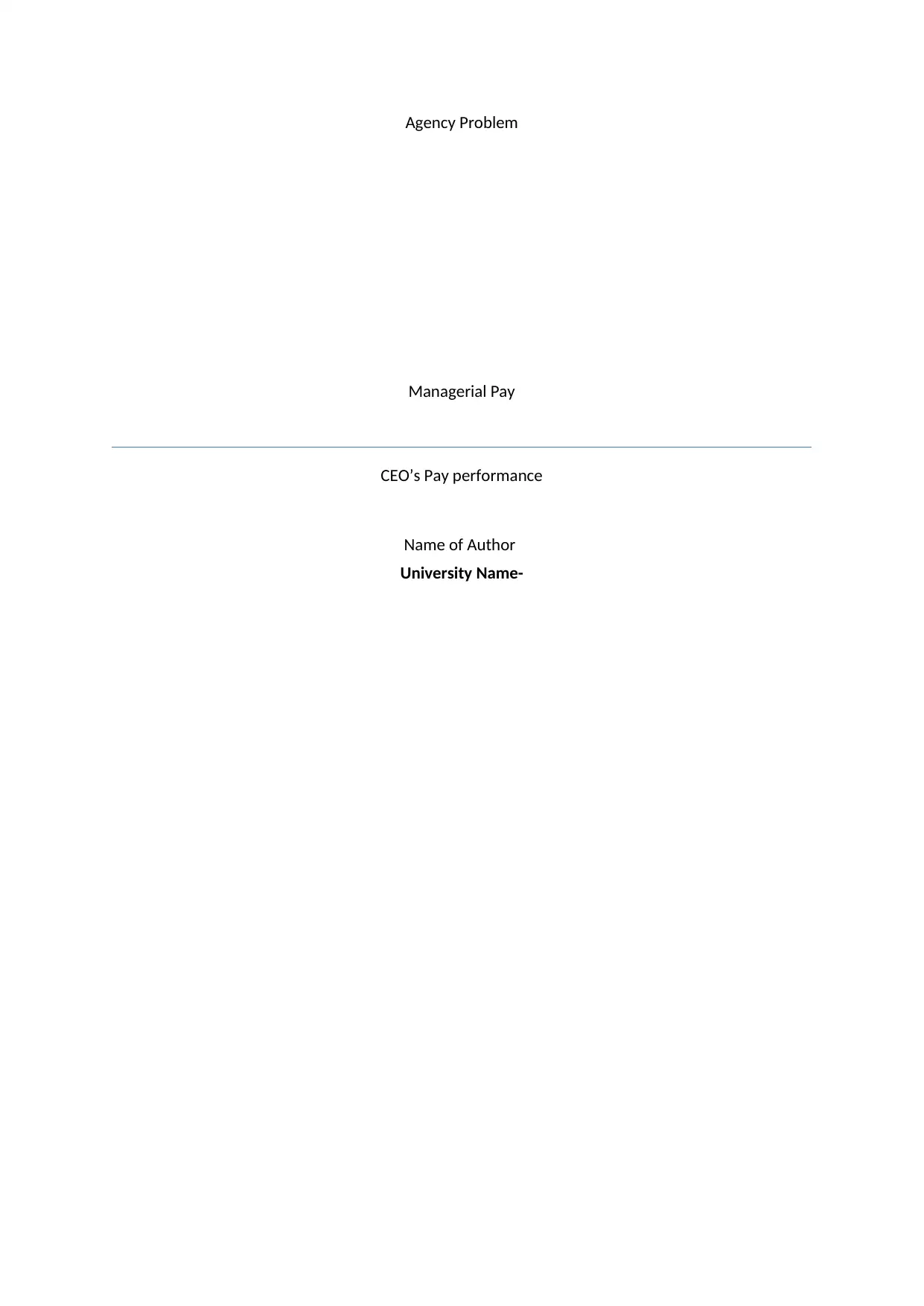
Agency Problem
Managerial Pay
CEO’s Pay performance
Name of Author
University Name-
Managerial Pay
CEO’s Pay performance
Name of Author
University Name-
Paraphrase This Document
Need a fresh take? Get an instant paraphrase of this document with our AI Paraphraser
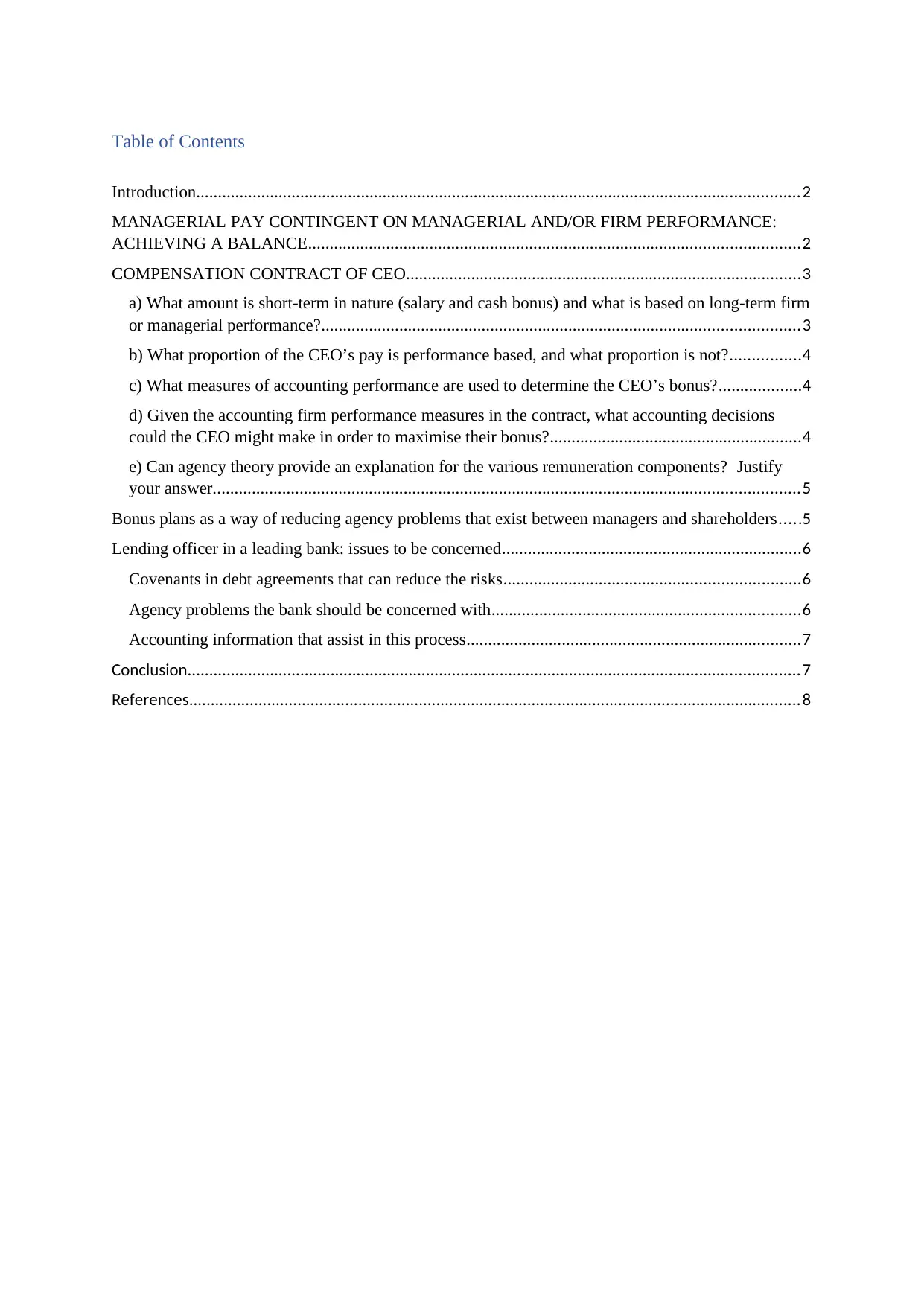
Table of Contents
Introduction...........................................................................................................................................2
MANAGERIAL PAY CONTINGENT ON MANAGERIAL AND/OR FIRM PERFORMANCE:
ACHIEVING A BALANCE.................................................................................................................2
COMPENSATION CONTRACT OF CEO...........................................................................................3
a) What amount is short-term in nature (salary and cash bonus) and what is based on long-term firm
or managerial performance?..............................................................................................................3
b) What proportion of the CEO’s pay is performance based, and what proportion is not?................4
c) What measures of accounting performance are used to determine the CEO’s bonus?...................4
d) Given the accounting firm performance measures in the contract, what accounting decisions
could the CEO might make in order to maximise their bonus?..........................................................4
e) Can agency theory provide an explanation for the various remuneration components? Justify
your answer.......................................................................................................................................5
Bonus plans as a way of reducing agency problems that exist between managers and shareholders.....5
Lending officer in a leading bank: issues to be concerned.....................................................................6
Covenants in debt agreements that can reduce the risks....................................................................6
Agency problems the bank should be concerned with.......................................................................6
Accounting information that assist in this process.............................................................................7
Conclusion.............................................................................................................................................7
References.............................................................................................................................................8
Introduction...........................................................................................................................................2
MANAGERIAL PAY CONTINGENT ON MANAGERIAL AND/OR FIRM PERFORMANCE:
ACHIEVING A BALANCE.................................................................................................................2
COMPENSATION CONTRACT OF CEO...........................................................................................3
a) What amount is short-term in nature (salary and cash bonus) and what is based on long-term firm
or managerial performance?..............................................................................................................3
b) What proportion of the CEO’s pay is performance based, and what proportion is not?................4
c) What measures of accounting performance are used to determine the CEO’s bonus?...................4
d) Given the accounting firm performance measures in the contract, what accounting decisions
could the CEO might make in order to maximise their bonus?..........................................................4
e) Can agency theory provide an explanation for the various remuneration components? Justify
your answer.......................................................................................................................................5
Bonus plans as a way of reducing agency problems that exist between managers and shareholders.....5
Lending officer in a leading bank: issues to be concerned.....................................................................6
Covenants in debt agreements that can reduce the risks....................................................................6
Agency problems the bank should be concerned with.......................................................................6
Accounting information that assist in this process.............................................................................7
Conclusion.............................................................................................................................................7
References.............................................................................................................................................8
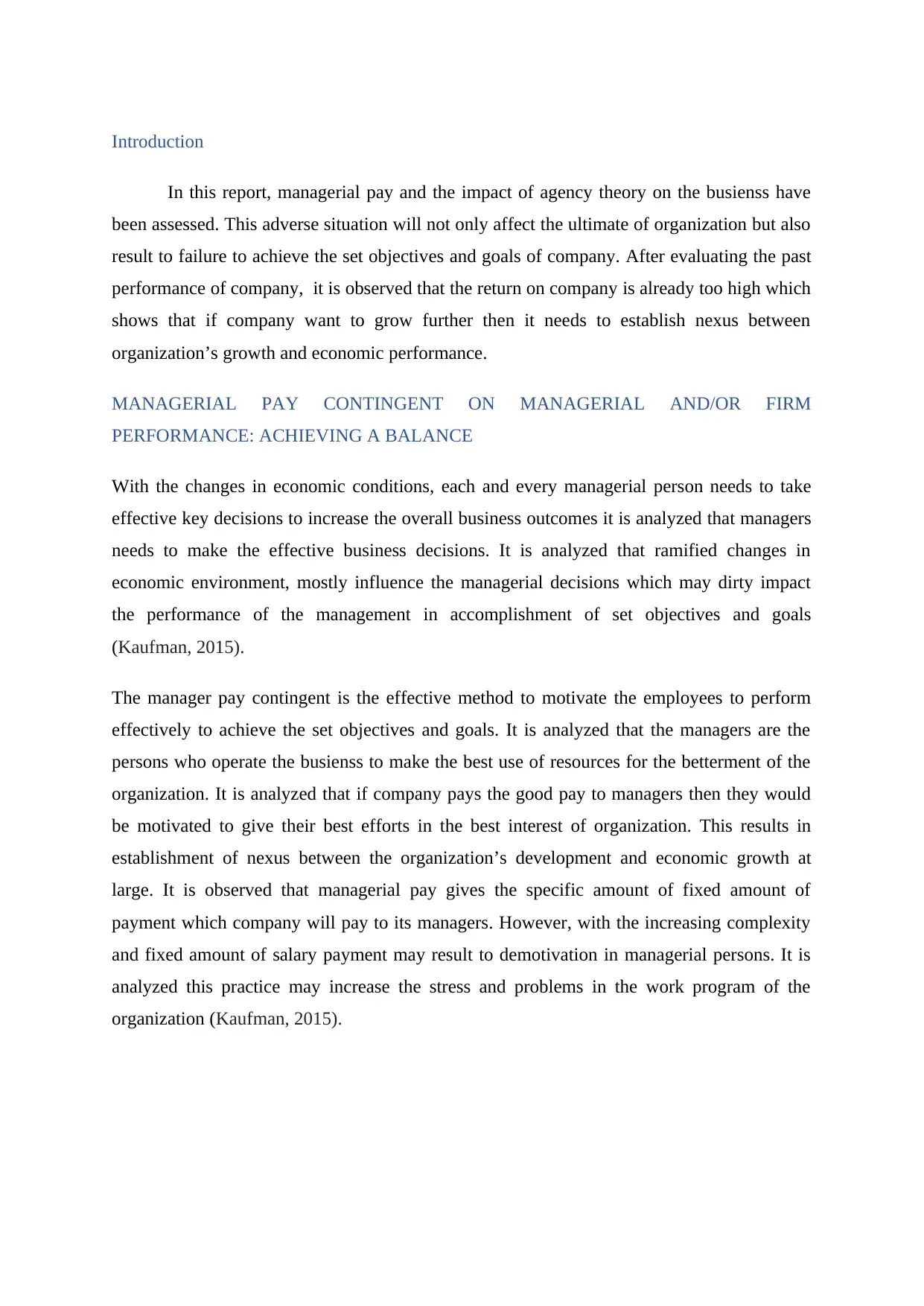
Introduction
In this report, managerial pay and the impact of agency theory on the busienss have
been assessed. This adverse situation will not only affect the ultimate of organization but also
result to failure to achieve the set objectives and goals of company. After evaluating the past
performance of company, it is observed that the return on company is already too high which
shows that if company want to grow further then it needs to establish nexus between
organization’s growth and economic performance.
MANAGERIAL PAY CONTINGENT ON MANAGERIAL AND/OR FIRM
PERFORMANCE: ACHIEVING A BALANCE
With the changes in economic conditions, each and every managerial person needs to take
effective key decisions to increase the overall business outcomes it is analyzed that managers
needs to make the effective business decisions. It is analyzed that ramified changes in
economic environment, mostly influence the managerial decisions which may dirty impact
the performance of the management in accomplishment of set objectives and goals
(Kaufman, 2015).
The manager pay contingent is the effective method to motivate the employees to perform
effectively to achieve the set objectives and goals. It is analyzed that the managers are the
persons who operate the busienss to make the best use of resources for the betterment of the
organization. It is analyzed that if company pays the good pay to managers then they would
be motivated to give their best efforts in the best interest of organization. This results in
establishment of nexus between the organization’s development and economic growth at
large. It is observed that managerial pay gives the specific amount of fixed amount of
payment which company will pay to its managers. However, with the increasing complexity
and fixed amount of salary payment may result to demotivation in managerial persons. It is
analyzed this practice may increase the stress and problems in the work program of the
organization (Kaufman, 2015).
In this report, managerial pay and the impact of agency theory on the busienss have
been assessed. This adverse situation will not only affect the ultimate of organization but also
result to failure to achieve the set objectives and goals of company. After evaluating the past
performance of company, it is observed that the return on company is already too high which
shows that if company want to grow further then it needs to establish nexus between
organization’s growth and economic performance.
MANAGERIAL PAY CONTINGENT ON MANAGERIAL AND/OR FIRM
PERFORMANCE: ACHIEVING A BALANCE
With the changes in economic conditions, each and every managerial person needs to take
effective key decisions to increase the overall business outcomes it is analyzed that managers
needs to make the effective business decisions. It is analyzed that ramified changes in
economic environment, mostly influence the managerial decisions which may dirty impact
the performance of the management in accomplishment of set objectives and goals
(Kaufman, 2015).
The manager pay contingent is the effective method to motivate the employees to perform
effectively to achieve the set objectives and goals. It is analyzed that the managers are the
persons who operate the busienss to make the best use of resources for the betterment of the
organization. It is analyzed that if company pays the good pay to managers then they would
be motivated to give their best efforts in the best interest of organization. This results in
establishment of nexus between the organization’s development and economic growth at
large. It is observed that managerial pay gives the specific amount of fixed amount of
payment which company will pay to its managers. However, with the increasing complexity
and fixed amount of salary payment may result to demotivation in managerial persons. It is
analyzed this practice may increase the stress and problems in the work program of the
organization (Kaufman, 2015).
⊘ This is a preview!⊘
Do you want full access?
Subscribe today to unlock all pages.

Trusted by 1+ million students worldwide
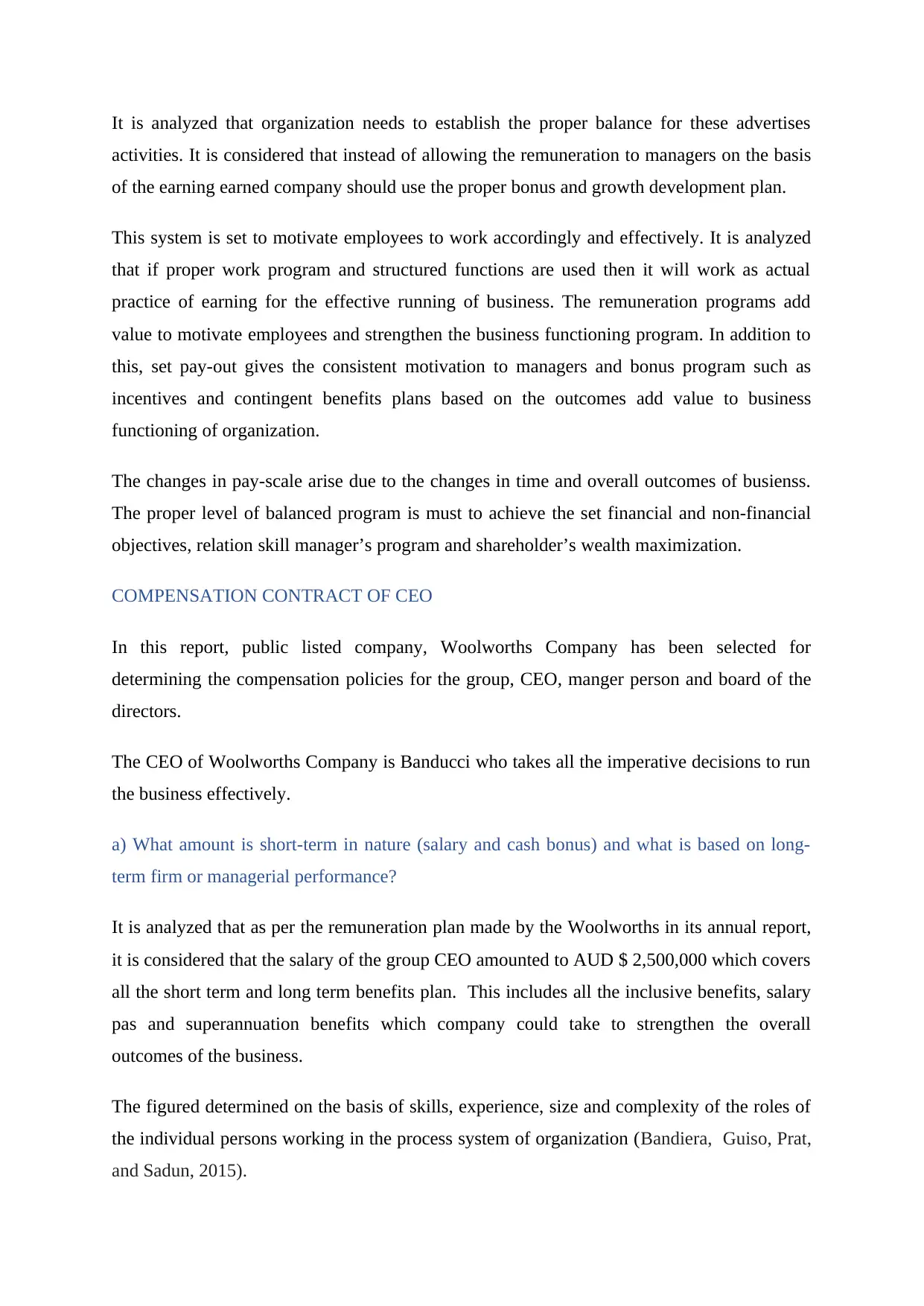
It is analyzed that organization needs to establish the proper balance for these advertises
activities. It is considered that instead of allowing the remuneration to managers on the basis
of the earning earned company should use the proper bonus and growth development plan.
This system is set to motivate employees to work accordingly and effectively. It is analyzed
that if proper work program and structured functions are used then it will work as actual
practice of earning for the effective running of business. The remuneration programs add
value to motivate employees and strengthen the business functioning program. In addition to
this, set pay-out gives the consistent motivation to managers and bonus program such as
incentives and contingent benefits plans based on the outcomes add value to business
functioning of organization.
The changes in pay-scale arise due to the changes in time and overall outcomes of busienss.
The proper level of balanced program is must to achieve the set financial and non-financial
objectives, relation skill manager’s program and shareholder’s wealth maximization.
COMPENSATION CONTRACT OF CEO
In this report, public listed company, Woolworths Company has been selected for
determining the compensation policies for the group, CEO, manger person and board of the
directors.
The CEO of Woolworths Company is Banducci who takes all the imperative decisions to run
the business effectively.
a) What amount is short-term in nature (salary and cash bonus) and what is based on long-
term firm or managerial performance?
It is analyzed that as per the remuneration plan made by the Woolworths in its annual report,
it is considered that the salary of the group CEO amounted to AUD $ 2,500,000 which covers
all the short term and long term benefits plan. This includes all the inclusive benefits, salary
pas and superannuation benefits which company could take to strengthen the overall
outcomes of the business.
The figured determined on the basis of skills, experience, size and complexity of the roles of
the individual persons working in the process system of organization (Bandiera, Guiso, Prat,
and Sadun, 2015).
activities. It is considered that instead of allowing the remuneration to managers on the basis
of the earning earned company should use the proper bonus and growth development plan.
This system is set to motivate employees to work accordingly and effectively. It is analyzed
that if proper work program and structured functions are used then it will work as actual
practice of earning for the effective running of business. The remuneration programs add
value to motivate employees and strengthen the business functioning program. In addition to
this, set pay-out gives the consistent motivation to managers and bonus program such as
incentives and contingent benefits plans based on the outcomes add value to business
functioning of organization.
The changes in pay-scale arise due to the changes in time and overall outcomes of busienss.
The proper level of balanced program is must to achieve the set financial and non-financial
objectives, relation skill manager’s program and shareholder’s wealth maximization.
COMPENSATION CONTRACT OF CEO
In this report, public listed company, Woolworths Company has been selected for
determining the compensation policies for the group, CEO, manger person and board of the
directors.
The CEO of Woolworths Company is Banducci who takes all the imperative decisions to run
the business effectively.
a) What amount is short-term in nature (salary and cash bonus) and what is based on long-
term firm or managerial performance?
It is analyzed that as per the remuneration plan made by the Woolworths in its annual report,
it is considered that the salary of the group CEO amounted to AUD $ 2,500,000 which covers
all the short term and long term benefits plan. This includes all the inclusive benefits, salary
pas and superannuation benefits which company could take to strengthen the overall
outcomes of the business.
The figured determined on the basis of skills, experience, size and complexity of the roles of
the individual persons working in the process system of organization (Bandiera, Guiso, Prat,
and Sadun, 2015).
Paraphrase This Document
Need a fresh take? Get an instant paraphrase of this document with our AI Paraphraser
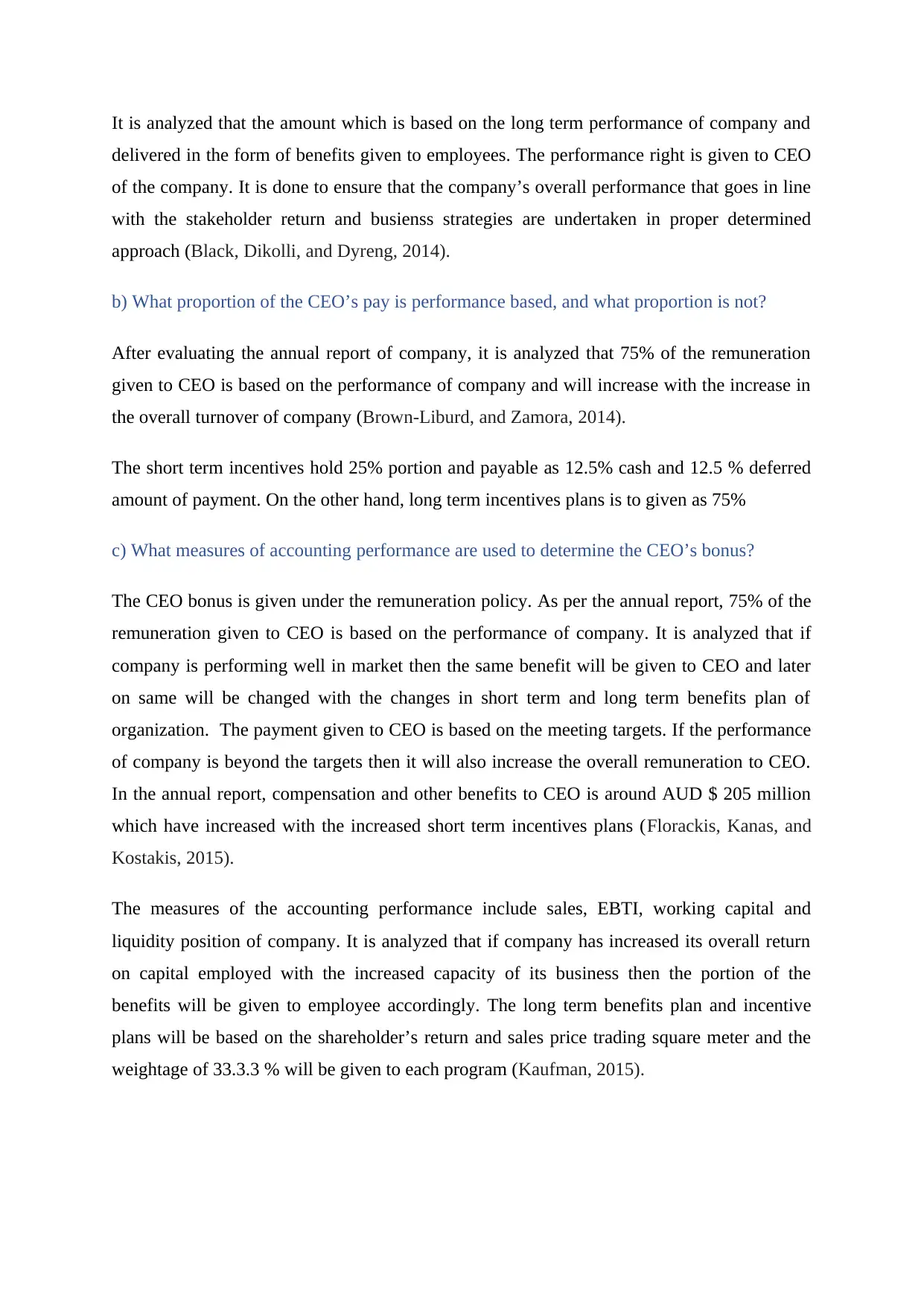
It is analyzed that the amount which is based on the long term performance of company and
delivered in the form of benefits given to employees. The performance right is given to CEO
of the company. It is done to ensure that the company’s overall performance that goes in line
with the stakeholder return and busienss strategies are undertaken in proper determined
approach (Black, Dikolli, and Dyreng, 2014).
b) What proportion of the CEO’s pay is performance based, and what proportion is not?
After evaluating the annual report of company, it is analyzed that 75% of the remuneration
given to CEO is based on the performance of company and will increase with the increase in
the overall turnover of company (Brown-Liburd, and Zamora, 2014).
The short term incentives hold 25% portion and payable as 12.5% cash and 12.5 % deferred
amount of payment. On the other hand, long term incentives plans is to given as 75%
c) What measures of accounting performance are used to determine the CEO’s bonus?
The CEO bonus is given under the remuneration policy. As per the annual report, 75% of the
remuneration given to CEO is based on the performance of company. It is analyzed that if
company is performing well in market then the same benefit will be given to CEO and later
on same will be changed with the changes in short term and long term benefits plan of
organization. The payment given to CEO is based on the meeting targets. If the performance
of company is beyond the targets then it will also increase the overall remuneration to CEO.
In the annual report, compensation and other benefits to CEO is around AUD $ 205 million
which have increased with the increased short term incentives plans (Florackis, Kanas, and
Kostakis, 2015).
The measures of the accounting performance include sales, EBTI, working capital and
liquidity position of company. It is analyzed that if company has increased its overall return
on capital employed with the increased capacity of its business then the portion of the
benefits will be given to employee accordingly. The long term benefits plan and incentive
plans will be based on the shareholder’s return and sales price trading square meter and the
weightage of 33.3.3 % will be given to each program (Kaufman, 2015).
delivered in the form of benefits given to employees. The performance right is given to CEO
of the company. It is done to ensure that the company’s overall performance that goes in line
with the stakeholder return and busienss strategies are undertaken in proper determined
approach (Black, Dikolli, and Dyreng, 2014).
b) What proportion of the CEO’s pay is performance based, and what proportion is not?
After evaluating the annual report of company, it is analyzed that 75% of the remuneration
given to CEO is based on the performance of company and will increase with the increase in
the overall turnover of company (Brown-Liburd, and Zamora, 2014).
The short term incentives hold 25% portion and payable as 12.5% cash and 12.5 % deferred
amount of payment. On the other hand, long term incentives plans is to given as 75%
c) What measures of accounting performance are used to determine the CEO’s bonus?
The CEO bonus is given under the remuneration policy. As per the annual report, 75% of the
remuneration given to CEO is based on the performance of company. It is analyzed that if
company is performing well in market then the same benefit will be given to CEO and later
on same will be changed with the changes in short term and long term benefits plan of
organization. The payment given to CEO is based on the meeting targets. If the performance
of company is beyond the targets then it will also increase the overall remuneration to CEO.
In the annual report, compensation and other benefits to CEO is around AUD $ 205 million
which have increased with the increased short term incentives plans (Florackis, Kanas, and
Kostakis, 2015).
The measures of the accounting performance include sales, EBTI, working capital and
liquidity position of company. It is analyzed that if company has increased its overall return
on capital employed with the increased capacity of its business then the portion of the
benefits will be given to employee accordingly. The long term benefits plan and incentive
plans will be based on the shareholder’s return and sales price trading square meter and the
weightage of 33.3.3 % will be given to each program (Kaufman, 2015).
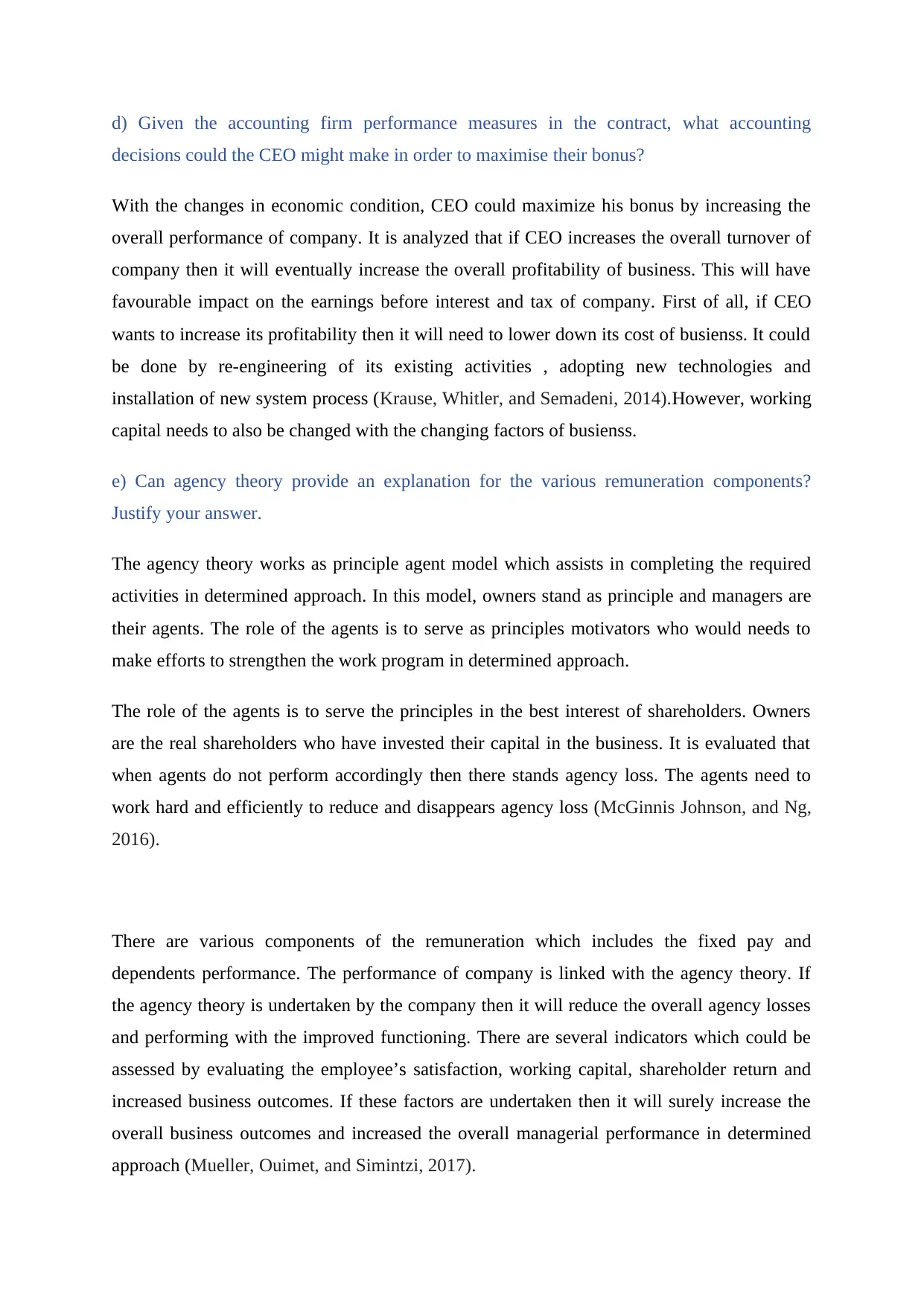
d) Given the accounting firm performance measures in the contract, what accounting
decisions could the CEO might make in order to maximise their bonus?
With the changes in economic condition, CEO could maximize his bonus by increasing the
overall performance of company. It is analyzed that if CEO increases the overall turnover of
company then it will eventually increase the overall profitability of business. This will have
favourable impact on the earnings before interest and tax of company. First of all, if CEO
wants to increase its profitability then it will need to lower down its cost of busienss. It could
be done by re-engineering of its existing activities , adopting new technologies and
installation of new system process (Krause, Whitler, and Semadeni, 2014).However, working
capital needs to also be changed with the changing factors of busienss.
e) Can agency theory provide an explanation for the various remuneration components?
Justify your answer.
The agency theory works as principle agent model which assists in completing the required
activities in determined approach. In this model, owners stand as principle and managers are
their agents. The role of the agents is to serve as principles motivators who would needs to
make efforts to strengthen the work program in determined approach.
The role of the agents is to serve the principles in the best interest of shareholders. Owners
are the real shareholders who have invested their capital in the business. It is evaluated that
when agents do not perform accordingly then there stands agency loss. The agents need to
work hard and efficiently to reduce and disappears agency loss (McGinnis Johnson, and Ng,
2016).
There are various components of the remuneration which includes the fixed pay and
dependents performance. The performance of company is linked with the agency theory. If
the agency theory is undertaken by the company then it will reduce the overall agency losses
and performing with the improved functioning. There are several indicators which could be
assessed by evaluating the employee’s satisfaction, working capital, shareholder return and
increased business outcomes. If these factors are undertaken then it will surely increase the
overall business outcomes and increased the overall managerial performance in determined
approach (Mueller, Ouimet, and Simintzi, 2017).
decisions could the CEO might make in order to maximise their bonus?
With the changes in economic condition, CEO could maximize his bonus by increasing the
overall performance of company. It is analyzed that if CEO increases the overall turnover of
company then it will eventually increase the overall profitability of business. This will have
favourable impact on the earnings before interest and tax of company. First of all, if CEO
wants to increase its profitability then it will need to lower down its cost of busienss. It could
be done by re-engineering of its existing activities , adopting new technologies and
installation of new system process (Krause, Whitler, and Semadeni, 2014).However, working
capital needs to also be changed with the changing factors of busienss.
e) Can agency theory provide an explanation for the various remuneration components?
Justify your answer.
The agency theory works as principle agent model which assists in completing the required
activities in determined approach. In this model, owners stand as principle and managers are
their agents. The role of the agents is to serve as principles motivators who would needs to
make efforts to strengthen the work program in determined approach.
The role of the agents is to serve the principles in the best interest of shareholders. Owners
are the real shareholders who have invested their capital in the business. It is evaluated that
when agents do not perform accordingly then there stands agency loss. The agents need to
work hard and efficiently to reduce and disappears agency loss (McGinnis Johnson, and Ng,
2016).
There are various components of the remuneration which includes the fixed pay and
dependents performance. The performance of company is linked with the agency theory. If
the agency theory is undertaken by the company then it will reduce the overall agency losses
and performing with the improved functioning. There are several indicators which could be
assessed by evaluating the employee’s satisfaction, working capital, shareholder return and
increased business outcomes. If these factors are undertaken then it will surely increase the
overall business outcomes and increased the overall managerial performance in determined
approach (Mueller, Ouimet, and Simintzi, 2017).
⊘ This is a preview!⊘
Do you want full access?
Subscribe today to unlock all pages.

Trusted by 1+ million students worldwide
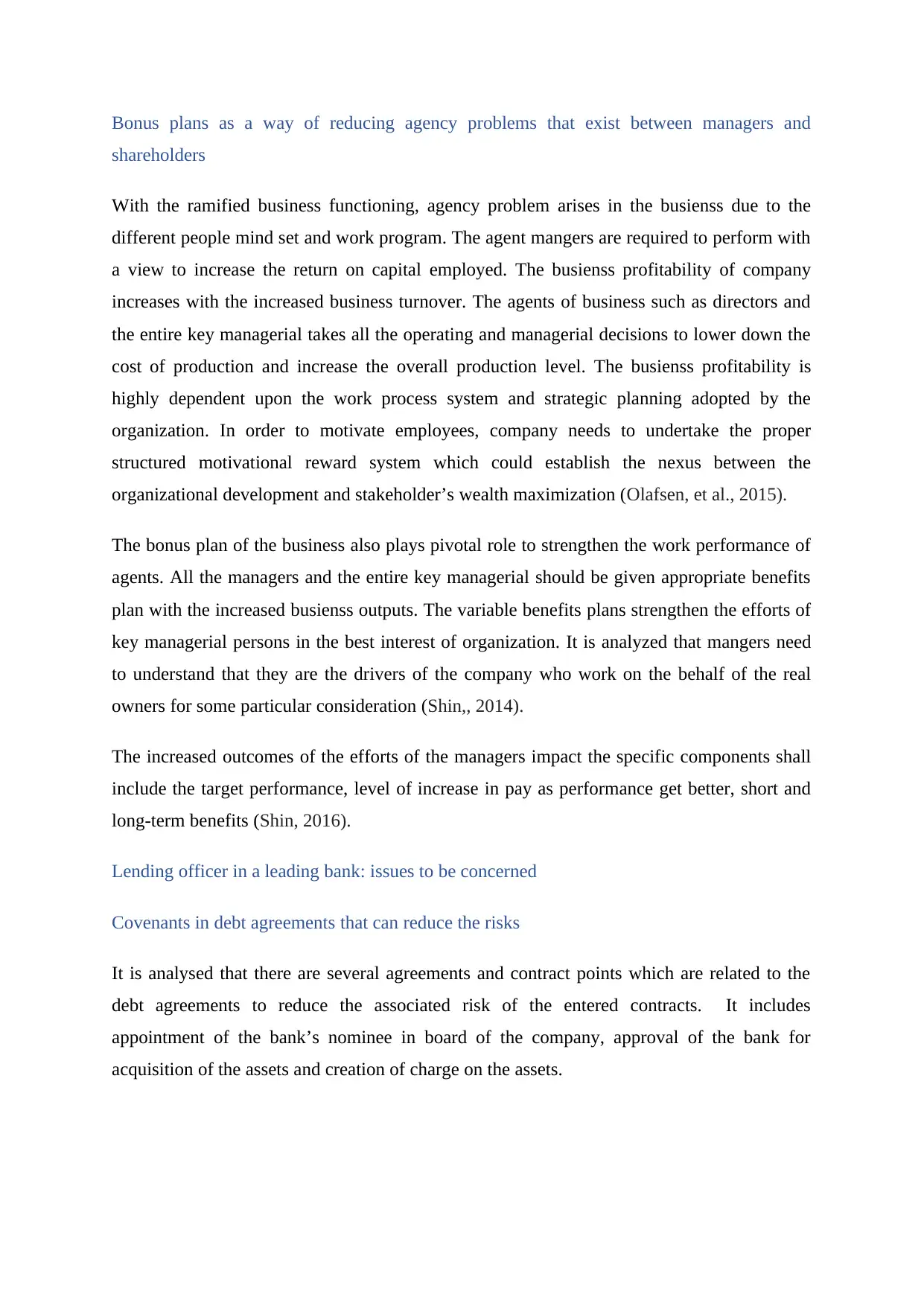
Bonus plans as a way of reducing agency problems that exist between managers and
shareholders
With the ramified business functioning, agency problem arises in the busienss due to the
different people mind set and work program. The agent mangers are required to perform with
a view to increase the return on capital employed. The busienss profitability of company
increases with the increased business turnover. The agents of business such as directors and
the entire key managerial takes all the operating and managerial decisions to lower down the
cost of production and increase the overall production level. The busienss profitability is
highly dependent upon the work process system and strategic planning adopted by the
organization. In order to motivate employees, company needs to undertake the proper
structured motivational reward system which could establish the nexus between the
organizational development and stakeholder’s wealth maximization (Olafsen, et al., 2015).
The bonus plan of the business also plays pivotal role to strengthen the work performance of
agents. All the managers and the entire key managerial should be given appropriate benefits
plan with the increased busienss outputs. The variable benefits plans strengthen the efforts of
key managerial persons in the best interest of organization. It is analyzed that mangers need
to understand that they are the drivers of the company who work on the behalf of the real
owners for some particular consideration (Shin,, 2014).
The increased outcomes of the efforts of the managers impact the specific components shall
include the target performance, level of increase in pay as performance get better, short and
long-term benefits (Shin, 2016).
Lending officer in a leading bank: issues to be concerned
Covenants in debt agreements that can reduce the risks
It is analysed that there are several agreements and contract points which are related to the
debt agreements to reduce the associated risk of the entered contracts. It includes
appointment of the bank’s nominee in board of the company, approval of the bank for
acquisition of the assets and creation of charge on the assets.
shareholders
With the ramified business functioning, agency problem arises in the busienss due to the
different people mind set and work program. The agent mangers are required to perform with
a view to increase the return on capital employed. The busienss profitability of company
increases with the increased business turnover. The agents of business such as directors and
the entire key managerial takes all the operating and managerial decisions to lower down the
cost of production and increase the overall production level. The busienss profitability is
highly dependent upon the work process system and strategic planning adopted by the
organization. In order to motivate employees, company needs to undertake the proper
structured motivational reward system which could establish the nexus between the
organizational development and stakeholder’s wealth maximization (Olafsen, et al., 2015).
The bonus plan of the business also plays pivotal role to strengthen the work performance of
agents. All the managers and the entire key managerial should be given appropriate benefits
plan with the increased busienss outputs. The variable benefits plans strengthen the efforts of
key managerial persons in the best interest of organization. It is analyzed that mangers need
to understand that they are the drivers of the company who work on the behalf of the real
owners for some particular consideration (Shin,, 2014).
The increased outcomes of the efforts of the managers impact the specific components shall
include the target performance, level of increase in pay as performance get better, short and
long-term benefits (Shin, 2016).
Lending officer in a leading bank: issues to be concerned
Covenants in debt agreements that can reduce the risks
It is analysed that there are several agreements and contract points which are related to the
debt agreements to reduce the associated risk of the entered contracts. It includes
appointment of the bank’s nominee in board of the company, approval of the bank for
acquisition of the assets and creation of charge on the assets.
Paraphrase This Document
Need a fresh take? Get an instant paraphrase of this document with our AI Paraphraser
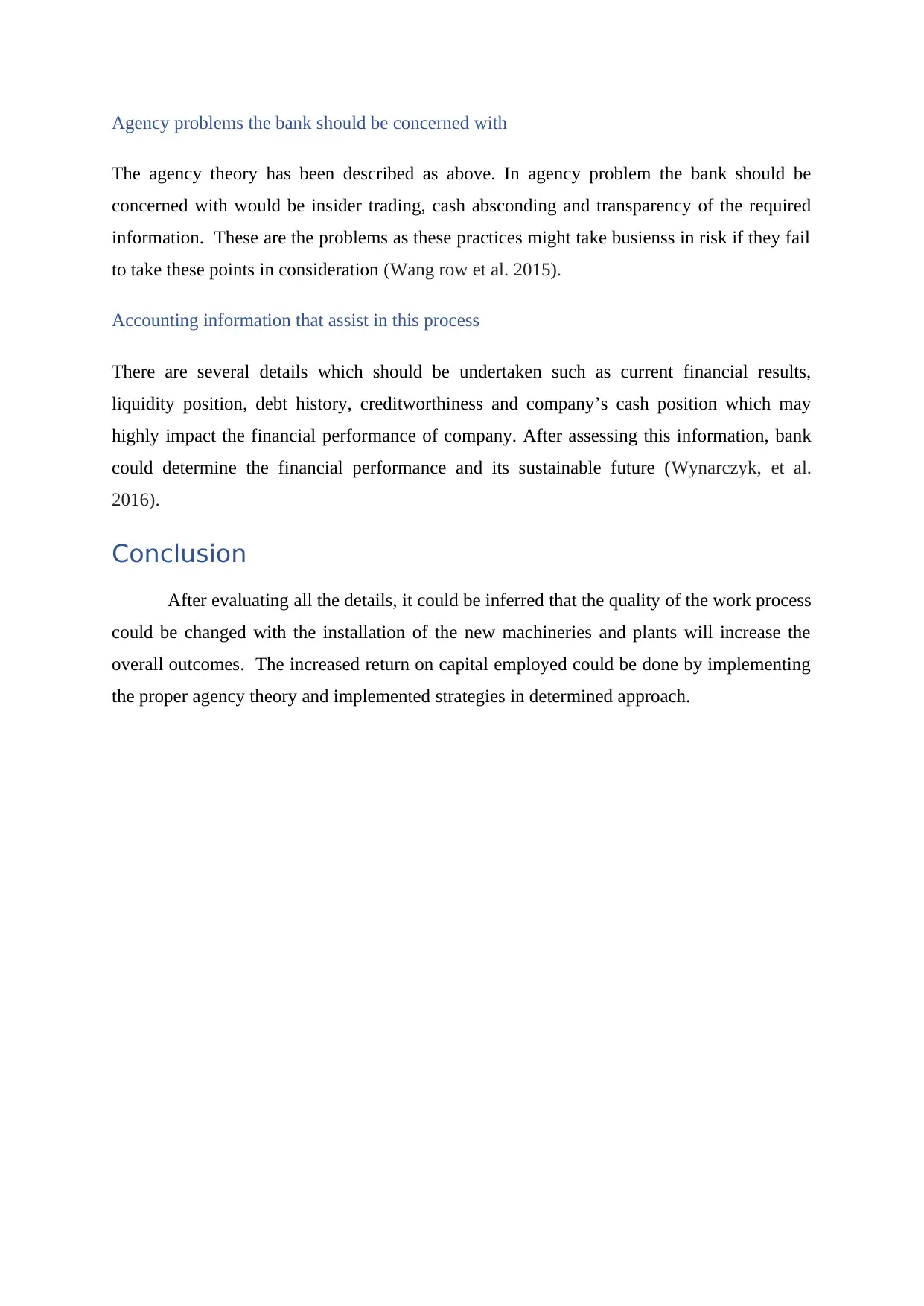
Agency problems the bank should be concerned with
The agency theory has been described as above. In agency problem the bank should be
concerned with would be insider trading, cash absconding and transparency of the required
information. These are the problems as these practices might take busienss in risk if they fail
to take these points in consideration (Wang row et al. 2015).
Accounting information that assist in this process
There are several details which should be undertaken such as current financial results,
liquidity position, debt history, creditworthiness and company’s cash position which may
highly impact the financial performance of company. After assessing this information, bank
could determine the financial performance and its sustainable future (Wynarczyk, et al.
2016).
Conclusion
After evaluating all the details, it could be inferred that the quality of the work process
could be changed with the installation of the new machineries and plants will increase the
overall outcomes. The increased return on capital employed could be done by implementing
the proper agency theory and implemented strategies in determined approach.
The agency theory has been described as above. In agency problem the bank should be
concerned with would be insider trading, cash absconding and transparency of the required
information. These are the problems as these practices might take busienss in risk if they fail
to take these points in consideration (Wang row et al. 2015).
Accounting information that assist in this process
There are several details which should be undertaken such as current financial results,
liquidity position, debt history, creditworthiness and company’s cash position which may
highly impact the financial performance of company. After assessing this information, bank
could determine the financial performance and its sustainable future (Wynarczyk, et al.
2016).
Conclusion
After evaluating all the details, it could be inferred that the quality of the work process
could be changed with the installation of the new machineries and plants will increase the
overall outcomes. The increased return on capital employed could be done by implementing
the proper agency theory and implemented strategies in determined approach.
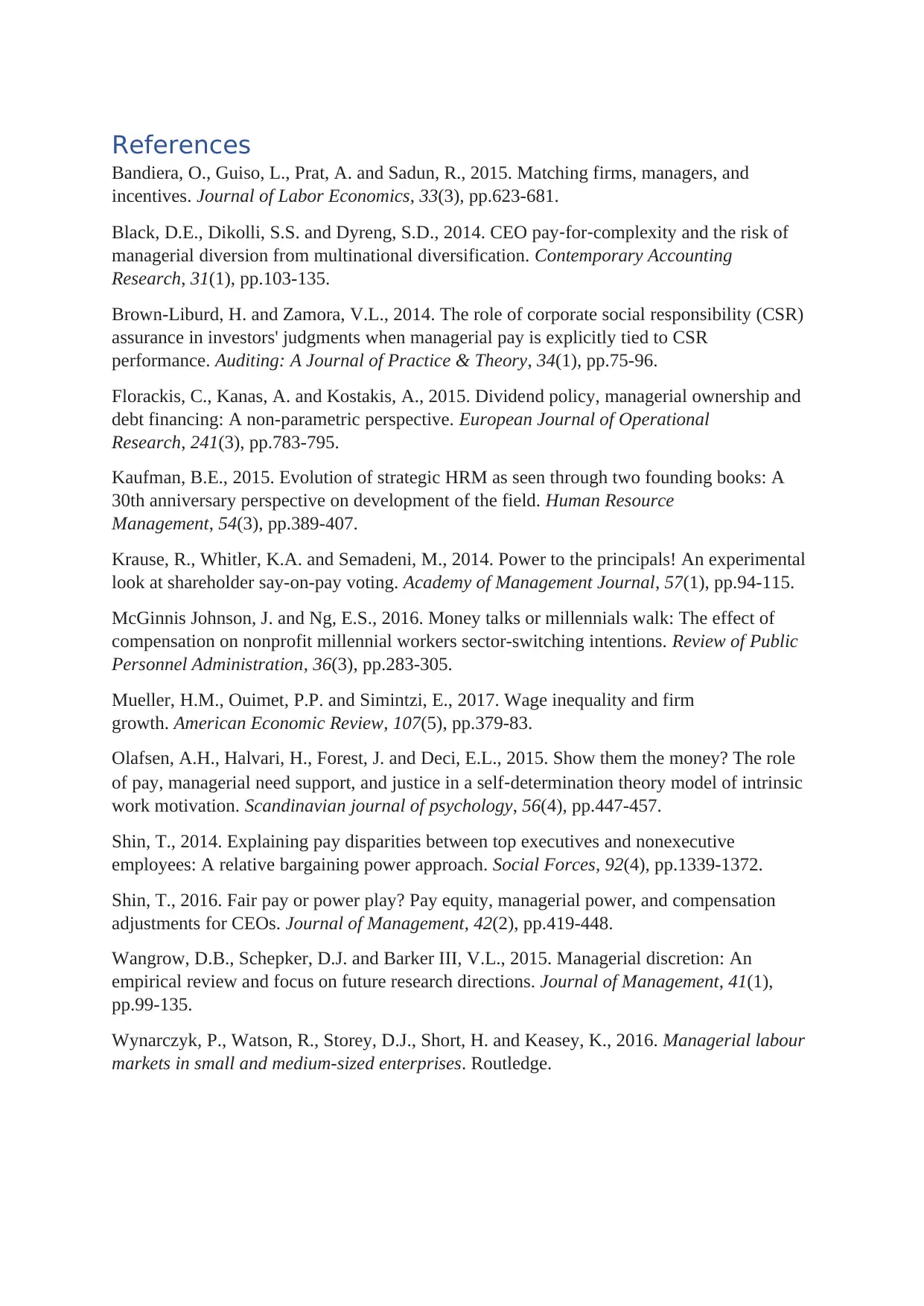
References
Bandiera, O., Guiso, L., Prat, A. and Sadun, R., 2015. Matching firms, managers, and
incentives. Journal of Labor Economics, 33(3), pp.623-681.
Black, D.E., Dikolli, S.S. and Dyreng, S.D., 2014. CEO pay‐for‐complexity and the risk of
managerial diversion from multinational diversification. Contemporary Accounting
Research, 31(1), pp.103-135.
Brown-Liburd, H. and Zamora, V.L., 2014. The role of corporate social responsibility (CSR)
assurance in investors' judgments when managerial pay is explicitly tied to CSR
performance. Auditing: A Journal of Practice & Theory, 34(1), pp.75-96.
Florackis, C., Kanas, A. and Kostakis, A., 2015. Dividend policy, managerial ownership and
debt financing: A non-parametric perspective. European Journal of Operational
Research, 241(3), pp.783-795.
Kaufman, B.E., 2015. Evolution of strategic HRM as seen through two founding books: A
30th anniversary perspective on development of the field. Human Resource
Management, 54(3), pp.389-407.
Krause, R., Whitler, K.A. and Semadeni, M., 2014. Power to the principals! An experimental
look at shareholder say-on-pay voting. Academy of Management Journal, 57(1), pp.94-115.
McGinnis Johnson, J. and Ng, E.S., 2016. Money talks or millennials walk: The effect of
compensation on nonprofit millennial workers sector-switching intentions. Review of Public
Personnel Administration, 36(3), pp.283-305.
Mueller, H.M., Ouimet, P.P. and Simintzi, E., 2017. Wage inequality and firm
growth. American Economic Review, 107(5), pp.379-83.
Olafsen, A.H., Halvari, H., Forest, J. and Deci, E.L., 2015. Show them the money? The role
of pay, managerial need support, and justice in a self‐determination theory model of intrinsic
work motivation. Scandinavian journal of psychology, 56(4), pp.447-457.
Shin, T., 2014. Explaining pay disparities between top executives and nonexecutive
employees: A relative bargaining power approach. Social Forces, 92(4), pp.1339-1372.
Shin, T., 2016. Fair pay or power play? Pay equity, managerial power, and compensation
adjustments for CEOs. Journal of Management, 42(2), pp.419-448.
Wangrow, D.B., Schepker, D.J. and Barker III, V.L., 2015. Managerial discretion: An
empirical review and focus on future research directions. Journal of Management, 41(1),
pp.99-135.
Wynarczyk, P., Watson, R., Storey, D.J., Short, H. and Keasey, K., 2016. Managerial labour
markets in small and medium-sized enterprises. Routledge.
Bandiera, O., Guiso, L., Prat, A. and Sadun, R., 2015. Matching firms, managers, and
incentives. Journal of Labor Economics, 33(3), pp.623-681.
Black, D.E., Dikolli, S.S. and Dyreng, S.D., 2014. CEO pay‐for‐complexity and the risk of
managerial diversion from multinational diversification. Contemporary Accounting
Research, 31(1), pp.103-135.
Brown-Liburd, H. and Zamora, V.L., 2014. The role of corporate social responsibility (CSR)
assurance in investors' judgments when managerial pay is explicitly tied to CSR
performance. Auditing: A Journal of Practice & Theory, 34(1), pp.75-96.
Florackis, C., Kanas, A. and Kostakis, A., 2015. Dividend policy, managerial ownership and
debt financing: A non-parametric perspective. European Journal of Operational
Research, 241(3), pp.783-795.
Kaufman, B.E., 2015. Evolution of strategic HRM as seen through two founding books: A
30th anniversary perspective on development of the field. Human Resource
Management, 54(3), pp.389-407.
Krause, R., Whitler, K.A. and Semadeni, M., 2014. Power to the principals! An experimental
look at shareholder say-on-pay voting. Academy of Management Journal, 57(1), pp.94-115.
McGinnis Johnson, J. and Ng, E.S., 2016. Money talks or millennials walk: The effect of
compensation on nonprofit millennial workers sector-switching intentions. Review of Public
Personnel Administration, 36(3), pp.283-305.
Mueller, H.M., Ouimet, P.P. and Simintzi, E., 2017. Wage inequality and firm
growth. American Economic Review, 107(5), pp.379-83.
Olafsen, A.H., Halvari, H., Forest, J. and Deci, E.L., 2015. Show them the money? The role
of pay, managerial need support, and justice in a self‐determination theory model of intrinsic
work motivation. Scandinavian journal of psychology, 56(4), pp.447-457.
Shin, T., 2014. Explaining pay disparities between top executives and nonexecutive
employees: A relative bargaining power approach. Social Forces, 92(4), pp.1339-1372.
Shin, T., 2016. Fair pay or power play? Pay equity, managerial power, and compensation
adjustments for CEOs. Journal of Management, 42(2), pp.419-448.
Wangrow, D.B., Schepker, D.J. and Barker III, V.L., 2015. Managerial discretion: An
empirical review and focus on future research directions. Journal of Management, 41(1),
pp.99-135.
Wynarczyk, P., Watson, R., Storey, D.J., Short, H. and Keasey, K., 2016. Managerial labour
markets in small and medium-sized enterprises. Routledge.
⊘ This is a preview!⊘
Do you want full access?
Subscribe today to unlock all pages.

Trusted by 1+ million students worldwide
1 out of 9
Related Documents
Your All-in-One AI-Powered Toolkit for Academic Success.
+13062052269
info@desklib.com
Available 24*7 on WhatsApp / Email
![[object Object]](/_next/static/media/star-bottom.7253800d.svg)
Unlock your academic potential
Copyright © 2020–2025 A2Z Services. All Rights Reserved. Developed and managed by ZUCOL.





